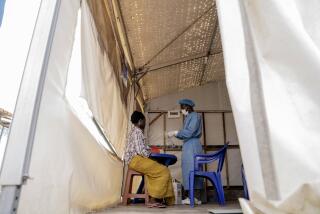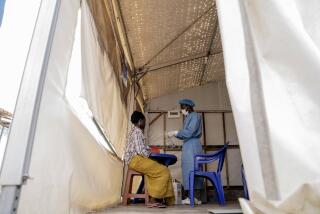SCIENCE / MEDICINE : Officials to Celebrate 10 Years of Smallpox-Free World
- Share via
ATLANTA — On Oct. 26, 1977, a cook in Merka, Somalia, came down with an illness that was to make him famous: History was to record him as the last person in the world to contract naturally occurring smallpox.
The 10th anniversary of this momentous medical milestone--the eradication of a disease that for centuries caused death and disfigurement--will be celebrated this week by health officials at the World Health Organization and at the national Centers for Disease Control here.
The center, which joined the worldwide effort to eliminate smallpox in 1966, will mark 10 years of a smallpox-free world with an awards presentation by U.S. Surgeon General C. Everett Koop and a display of smallpox eradication memorabilia. There also will be an address by Dr. Donald A. Henderson, the first director of the center’s smallpox eradication program.
Henderson was assigned to WHO’s headquarters in Geneva and became director of the global eradication program to which many nations, including the Soviet Union, contributed. He is now dean of the School of Hygiene and Public Health of Johns Hopkins University in Baltimore.
The only smallpox case diagnosed since 1977 was a laboratory-associated case that claimed the life of a medical photographer at a Birmingham, England, hospital in 1978.
The Somalia smallpox victim, Ali Maow Maalin, recovered from his illness, an isolate of the virus being quickly identified by a Centers for Disease Control virologist, James H. Nakano. Nakano, who joined the eradication effort at its beginning and set up the first U.S. smallpox laboratory, made the last diagnosis of a naturally occurring smallpox case.
“Toward the end (of the eradication effort) all the isolates turned out to be chicken pox,” said Nakano, now retired. “But in this case we did see the pox virus. We were able to diagnose it fairly easily.”
The International Commission on Certification of Smallpox Eradication waited for two years after the Somalia case before declaring the world free of smallpox in 1979. During that period, Nakano recalled, there were many reports of suspected smallpox but they turned out to be false alarms.
Health officials believe that the last case of smallpox in the United States occurred in 1949 in the lower Rio Grande River Valley of Texas.
But elsewhere in the world, millions of smallpox cases were being recorded, Nakano said. A 1966 effort by 21 countries was successful in ridding Central and West Africa of the disease and this success launched the global eradication campaign.
Smallpox is marked by headache, fever, chills, nausea and backache. After several days the victims would develop a rash that blistered, then pustules formed that would crust over. About one in four victims died. Survivors often were left with pockmarked faces and occasionally were blinded in one or both eyes.
Centers for Disease Control smallpox fighters credit worldwide cooperation with making possible the elimination of the disease, along with three technological tools--the jet injector gun, the bifurcated needle and freeze-dried vaccine.
The jet injector speeded up the vaccination process; the bifurcated, or forked, needle delivered the vaccine into the injection site more effectively than other needles, and freeze-dried vaccine remained stable because it did not require refrigeration.
The eradication campaign was also advanced by a strategy of surveillance and containment, rather than mass immunization, conceived by Dr. William H. Foege, former director of the center. The strategy not only led to containment of smallpox outbreaks but also helped conserve vaccine supplies.
Today, the smallpox virus is stored at only two places in the world--in Moscow and in a center laboratory in Atlanta, according to Nakano. The virus is kept in tanks of nitrogen at about minus 120 degrees--against the day when it might be needed to identify smallpox strains in fighting a new outbreak.






